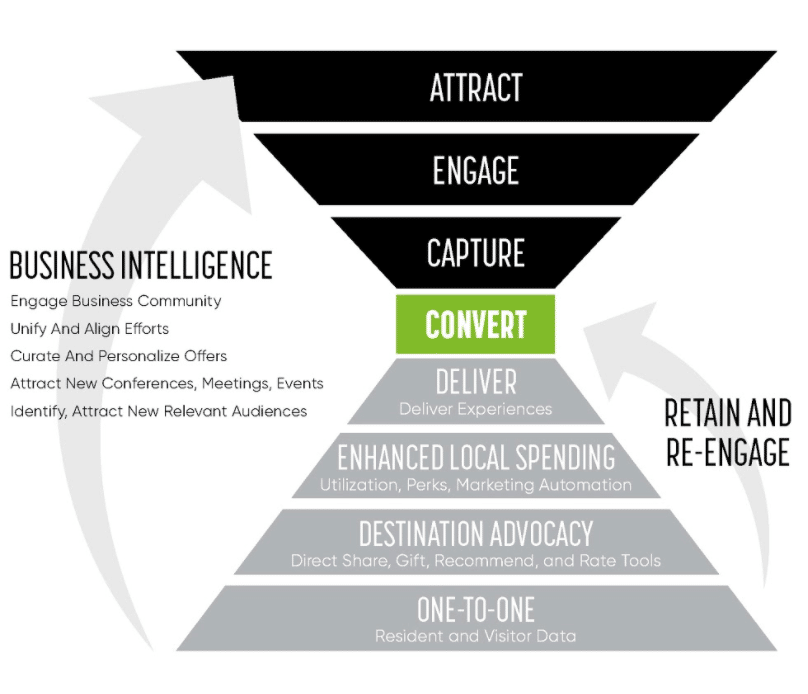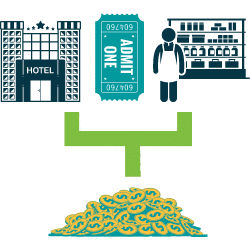Destination marketing organizations (DMOs) and Convention and Visitors’ Bureaus (CVBs) have long been the marketing engine for cities and regions (most destinations just have one of these organizations – the name CVB pre-dates DMO, but they’re essentially the same kind of entity). Primarily nonprofit, government organizations, they have been funded almost entirely by taxes collected on hotel stays. You know – that extra amount at the bottom of your bill when you go to checkout? This model has worked sufficiently in many markets…until COVID created a near-drought in hotel revenue. But the model also created a skewed approach to marketing, one that favored promoting lodging over the actual activities that many visitors to a region came to do in the first place. With hotel revenues dried up, DMOs and CVBs themselves are struggling. Many have had to make huge cuts in workforce, all at a time when so many of their local businesses need more support than ever. Now is a crucial time for DMOs and CVBs to problem-solve for the survival of their entire market, and one big way they can do so is by thinking differently and diversifying their revenue sources.
Redeam discussed these sentiments with the CEO of Bandwango, Mo Parikh. Bandwango is a Redeam partner company.The below Q&A is taken from an interview originally posted on Redeam.com. Check out that posting here.
Mo: Traditionally, DMOs and CVBs were created to attract out-of-town leisure and business visitors who would come into their cities, stay in their hotels, attend their conventions, and see their top attractions. The thing that COVID has done for DMOs and CVBs – and we’re seeing this across the board – is surface the notion that a destination’s locals are just as powerful a force as their visitors are, and more to the point, they’re the best investment in marketing that the DMO or CVB can make at this moment.
With fewer visitors than many destinations are used to, more DMOs and CVBs are shifting their thinking to, “How can we directly affect our local businesses, not through top-of-the-funnel inspirational marketing, but by driving dollars through the doors of local businesses in a trackable, measurable way?” So, we’re seeing a new focus for many DMOs on local tourism, but also on owning the entire customer journey – from inspiration to conversion.

Mo: Yes. Largely, DMOs/CVBs have been focused on the top of the consumer funnel. They have fantastic websites, generate incredible content, and they’re generally viewed as the local domain authority in these cities. They have incredible power over potential visitors during the inspiration phase. What DMOs haven’t really taken ownership of is bottom of the funnel actions like conversion and its measurement, which they typically leave up to a third party, whether that’s an OTA or an activity provider.
But now, that mentality is shifting and with it comes more and more DMOs who are spearheading the development of unique experiences within their destinations. Right now, the primary goal of these experiences is to engage locals and encourage them to spend money with tourism-dependent businesses. For many of our clients, visiting friends and family are a top driver of tourism, so this strategy also has a positive long-term effect. Ideally, once the local enjoys one of these in-market experiences, when their friends or family do travel again to visit them, the local is much more likely to take their visitors back to these experiences. This a real shift in perspective: repeat business isn’t going to come from a one-time visitor to your destination, but it is going to come from your locals

Mo: True, but look at where a significant amount of DMO/CVB funding comes from – from hotel tax, which is largely out-of-town visitors coming into the city. From my perspective, the limitation has mainly been political. I think that a lot of DMOs know that word-of-mouth is huge, but they need to satisfy their key stakeholders – largely the hoteliers – and if the DMO doesn’t deliver upon the promise behind that funding, in the back of their minds they’re always worrying, “Are we going to get cut off?” Now, we’re seeing local economies hurt, which is never good, but in some ways DMOs are finally getting to show that their expertise goes beyond just generating room nights. They’re being looked to as drivers of the local economy, which is what they’ve been this entire time. The difference being that for many organizations this is the first time those other KPIs are being given as much weight as room nights.
Mo: Right; this pivot inherently strengthens the DMOs’ relationships with local businesses. Membership, while a small component of a DMO’s revenue, is still a component, and a lot of times the local businesses paying for this membership question, “What am I getting for this?” At Bandwango, we enable DMOs with reporting that clearly shows people driven through the doors of these local businesses. By reporting that to members, the value can become completely apparent to them.
Mo: Absolutely, and I think that’s where the question of funding comes into play again. There’s a lot of value in stakeholders that see DMOs as generators of multi-stream revenue because that mentality spreads. When DMO initiatives are viewed as a community effort, whether that effort comes in the form of a savings pass or an ale trail or an attractions pass – it becomes a way for partners to collectively win. And it allows the DMO to put the bulk of their effort behind a cohesive marketing strategy that benefits multiple businesses, not just one big attraction or hotel that pays on the platinum level of membership. Instead, more and diverse KPIs give DMOs a reason to promote everybody. It also allows the DMO to better own the customer journey, gather customer data, and a develop a deeper understanding of their visitors’ (and locals’) behaviors.

Mo: If DMOs and CVBs can serve their mission of promoting a destination and supporting all their local businesses dependent upon tourism, but do so more effectively and with more quantifiable metrics to show their impact, that could open up discussions with the governing body of alternative revenues sources that aren’t solely reliant on a tax – for example, TID (Tourism Improvement District).
Now is a super-strong time for DMOs to get their footing back underneath them and show how they do serve local communities. Think of it like a future testimonial. Every community’s tourism-dependent businesses are hurting. Helping business owners during a time of need will put DMOs in a better position with their communities long after they’ve recovered.
Mo: Many DMOs and CVBs have shifted their focus to driving customers through the doors of their local businesses. My argument is that they should continue to focus on this once their hotels start to fill up again and visitors return. I’m not saying DMOs should stop trying to fill hotel rooms – nothing will replace the hotel occupancy tax (HOT) and effect of meetings & conventions as a source of revenue – but this is a great opportunity to showcase the impact the tourism industry has on local economies even without the benefit of visitors. Visitors who stay with their families, daytrippers and locals all have value that should not be ignored and cannot be quantified with HOT. I think reframing the conversation to include those groups is worthwhile.
Mo: Without question. And from the visitor’s perspective, they don’t need to have this kind of offering itemized. They want the convenience of buying an off-the-shelf destination package that gives themselves or their family a great experience. DMOs and CVBs are traditionally not for-profit organizations, but when DMOs develop these kinds of packaged experiences, they can start to see what it’s like to think like a profit-driven organization.
Plus, in our case, not all of our clients are creating paid products. About 65% are creating free passes like ale trails, savings passes, and check-in challenges. The value in these passes is that the DMO is creating products visitors and locals are using, and for most of them, that more than meets their needs. Most of the DMOs we work with just want to know how they can help their local businesses and prevent them from shutting their doors.
Mo: The idea of owning the customer journey and shifting the goal post from room nights to overall economic impact is such a departure from what they’ve traditionally been doing. DMO staffs are so creative, and I’ve found that they’re really up to try anything, but I think there’s a fear of perception. How can you justify spending dollars on a local initiative after visitors start coming back? How can you communicate the value of a visitor if you don’t have their room night tax? You can’t address those concerns if your revenue is only coming from one place. You can’t overcome those obstacles until you get stakeholders on board with new and diverse KPIs. Those are big obstacles, and I think what DMOs and CVBs need to do right now is recognize and acknowledge all of these constraints and be willing to think differently.
Mo: It’s been my pleasure! Thanks for asking so many great questions! I hope this helps illuminate more value for the entire marketplace of local and regional travel right now.
Mo likes to say he works for every member of the Bandwango team, and it’s 100% true. Mo’s ultimate goal for Bandwango is to utilize technology to transform the landscape of travel and build an all-star team and engaging culture while he’s at it!
